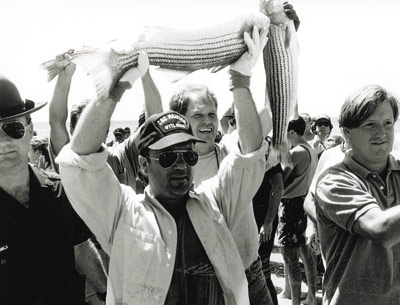Recalling the Striped Bass War, 20 Years On

The phrase “end of an era” is often heard, but it’s a rare thing to realize through the fog of day-to-day that an era really is gasping its last. The fog clears with time. In East Hampton 20 years ago, it was nearly impossible not to see and hear that a significant part of our local heritage was going by the board — not without a fight, and not without great pain. In October 1992, Tom Lester, a lifelong bayman and the husband of Town Councilwoman Cathy Lester, died of a heart attack. A week later, his daughter Della Lester received an anonymous letter. It read: “Your father was punished for killing bass. Good riddance! He was a pig to slaughter. Billy Joel should join him in hell.” She received more hate mail in the weeks that followed. The letters were postmarked Nassau County and bore commemorative sportfishing stamps. Hostility between baymen and sportfishermen had been building up for close to 10 years at that point, beginning in 1985, when striped bass were banned from the marketplace after bass spawned in the Hudson River were found to contain dangerous levels of polychlorinated biphenyls. Stripers were declared safe to eat again in 1990, but that same year the haul seine, a semi-circle of net paid off the transom of a dory launched from the ocean beaches, was banned. To baymen, the old haul seine, which in early days was hauled back to shore by horses, was the most efficient method of catching striped bass, the “money fish.” But to the ever-growing number of sportfishermen, it had become the engine of anti-conservation, although “conservation” by then was really a code word for getting a larger slice of the state’s striped bass quota. The discord between sporties and commercial fishermen. Statistics showed that sportfishermen had landed a half-million pounds of legal-size bass (over 36 inches) the year before, not including another quarter-million pounds that died after being caught and released. By contrast, commercial netters and market hook-and-line fishermen actually harvested less than their 128,000-pound quota that same year, 1989. In 1992, the year Tom Lester died, the New York Sportfishing Federation was pushing hard for the state to make striped bass a gamefish only, with the support of Owen Johnson, a state senator from Babylon. In the Town of East Hampton, the fight over striped bass became a civil war that pitted some of Montauk’s charter fishing fleet against their baymen neighbors. It was an angry time. Against this backdrop, the East Hampton Town Baymen’s Association organized a civil disobedience protest, with the enthusiastic support of the town supervisor, Tony Bullock, Councilwoman Lester, East Hampton Village Administrator Larry Cantwell, and State Assemblyman John Behan of Montauk. Billy Joel, whose 1989 hit “Downeaster Alexa” told the story of a bayman regulated out of his inshore bass fishery, raised the profile of the protest. “This stinks out loud. This situation is a product of rank politics and corruption,” Supervisor Bullock said of the ’92 bass laws that continued to ban the haul seine while giving the recreational fishery the lion’s share of the annual bass quota. On July 28, 1992, supporters and reporters gathered at Indian Wells Beach in Amagansett to watch Dan King launch his red, white, and blue flag dory into the surf and return with a haul seine containing a number of striped bass. As the protesters, including the participating officials and Mr. Joel, picked bass from the net, state police arrested them. The following day, Joe Pintauro’s play “Men’s Lives” opened at the Bay Street Theatre in Sag Harbor. It was the theater’s very first production and a smash hit. The play was a loose adaptation of Peter Matthiessen’s book of the same name, a history of East Hampton fishing families and their fight to survive. The title was plucked from Sir Walter Scott’s “The Antiquary”: “It’s no fish ye’re buyin’, it’s men’s lives.” On opening night, truer words were never spoken, and tears could not be contained. Mr. Pintauro, whose play is being revived at Bay Street starting on Tuesday night, coinciding with the 20th anniversary of the protest, said yesterday that while the real drama and angst of 1992 is gone, the loss of self the baymen felt at the time is being experienced by many today. “The present time has entered into the play. The economy, what’s happening to people losing their jobs, their vocation, what they have to offer to the rest of the world, what gave them their sense of being, who they were. Some economic fumble has left many — carpenters, policemen, people facing global change — in an empty state.” The ban on haulseining continues to this day. While striped bass are still the money fish, they are taken nowadays in traps, gillnets, or by hook-and-line. The number of full-time baymen remaining in East Hampton Town has shrunk dramatically.
